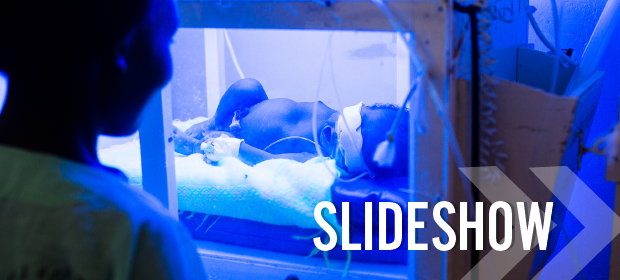Where We Work
See our interactive map


The Tenwek Mission Hospital neonatal intensive care unit is full of babies. White wooden incubators, each containing a newborn, are stacked three high against the walls. Some mothers press their faces up against the glass sides to watch their babies, while others feed their premature daughters or sons with syringes.
This ICU is crowded for a good reason. Tenwek Mission Hospital’s high quality of care is known across the Rift Valley. In Kenya, infant mortality rates have fallen over the past fifty years. Still, about 48 of every 1,000 babies born alive do not survive infancy.
The high-quality care for infants at Tenwek is also the reason Martha Sargoi is here. Martha—a kind, middle-aged woman with bouncy curls—is a nurse in a regional public health facility. She and about 20 other students have come to Tenwek as part of a USAID-funded IntraHealth International and Ministry of Health initiative that gives health workers the skills to save babies’ lives during the dangerous situations that can come up during the first days of life—especially for babies born prematurely.
Today, on Martha’s fifth and final day of training, she is shadowing the nurse in charge of the unit. As Martha scribbles notes about how to feed premature babies, the nurse in charge hurries over to an incubator where an infant has stopped breathing. The nurse rushes the baby across the room to a special table and immediately starts using a suction bulb and performing CPR. As Martha watches, the infant does not stir. Seconds pass slowly. Finally, the tiny chest rises and the baby draws breath again. Martha scribbles more notes.
Minutes later, the heart of another baby stops beating. The infant is so small it seems a miracle that he even exists. His body twists as he tries to draw oxygen. Students in Martha’s class gather to watch the sure movements of the nurse in charge as she gives the infant oxygen and gentle CPR. The students are tense. Then the heart monitor beeps on again and the students move on to another part of the unit.
Martha and her colleagues are in the vanguard of a new type of experiential-based learning in Kenya, in which health workers learn skills at hospitals and clinics where the best practices are used. Health training programs in Kenya often take place in hotels and other venues. But learning onsite in health facilities has proven to be a vastly more effective and less expensive way to pass skills along to other health workers, says Isaac Munene, IntraHealth’s FUNZOKenya regional hub manager for South Rift Region.
“It is important to do these trainings in a hospital because there are training materials available for practical applications, and we have experienced and competent staff who are able to mentor and coach the students,” Munene says. “It is cheaper than training in a hotel, so we are able to train more people with the same amount of dollars. It also helps in strengthening the systems of the training institutions and builds their capacity to manage in-service training. This project will end but the hospital’s training program will continue.”
This is the third such training conducted through IntraHealth’s USAID-funded FUNZOKenya project, which works with the government of Kenya to improve health worker education and training systems. IntraHealth and the Ministry of Health worked together to determine what kinds of training health workers most needed in the counties that rely on Tenwek for training. Then the organizations made it happen.
On the other side of the hospital, Catherine Cherono, a nurse at the Koiwa Health Center in Bomet County, is learning how to read an ultrasound—a tool that has typically been off-limits for nurses in the past, but which they’re now learning to use as a diagnostic tool. Trainer Dr. Elijah Terer glides the tool over the belly of a pregnant client as he explains to Catherine and a group of other students what the white wavy lines on the device mean. Catherine peers curiously over his shoulder.
Toward the end of the workshop, Catherine and the rest of the class write up action plans about how they’ll use what they’ve learned to reach their specific targets for the next three months. “The first thing I want to do is give feedback to our district management team,” Catherine says. She’s excited to share what she’s learned and wants to encourage her team to adopt some new practices (including using vacuum suction during childbirth, better managing issues around postpartum hemorrhage, and using partographs to greater effect). After three months, the Tenwek trainers will follow up with the trainees to see how they’re doing.
Back in the neonatal intensive care unit, Martha—the student with the bouncy curls—chats with one of the mothers. It’s now feeding time and dozens of women are holding their babies in their arms. The training program has been incredibly important for her, she says. “It feels so good to be part of saving a baby’s life.”
This work was conducted through IntraHealth International’s FUNZOKenya project, which is funded by the US Agency for International Development in Kenya. Tenwek Mission Hospital is situated 250 kilometers west of Nairobi, Kenya, and is the FUNZOKenya project's satellite training center in the South Rift Region. Photographs and reporting contributed by Trevor Snapp.



